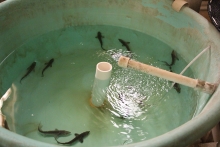
This week marks “Research Week” on our blog and we will be highlighting marine debris research projects throughout the week! Research is an important part of addressing marine debris, as we can only effectively address it by understanding the problem the best we can.
By: Chelsea M. Rochman, Guest Blogger and Assistant Professor in the Dept. of Ecology and Evolutionary Biology at the University of Toronto
When I go to the beach, anywhere in the world, I can kneel down and find small bits of plastic litter in the sand—these bits are called “microplastics.” Microplastic has become a common pollutant. It can be found globally, from the equator to the poles, in the ocean, lakes, and rivers. Microplastics are also eaten by and can be found inside nearly 700 species of animals, which likely mistake them for food.
If you take a closer look at this litter, you will notice that it is diverse— a handful of microplastics looks like party confetti, with several colors and shapes. This is because there are many types of microplastics that enter the environment.